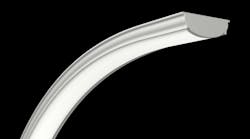DARMSTADT, Germany – September 5, 2019 – TE Connectivity (TE), a world leader in connectivity and sensors, is ready to bring 5G next-generation mobile communications technology to the rail industry that will help transform its riders’ experience. TE is already supplying onboard antennas that are ready for 5G, which is now beginning to be rolled out all around the world, and which will have massive implications for the quality and speed of data communications.
With 5G, data transmission will be up to 100 times faster than with LTE, reaching wireless data transmission speeds of up to 20 Gbit/s. It will provide rail operators with the possibility of providing passengers with high-quality real-time travel information as well as interruption-free Wi-Fi, including the most demanding of video applications. But operators will have to invest in new onboard communications equipment.
TE offers antennas for mounting outside on vehicle rooftops and on inside ceilings.
New wideband MiMo rooftop antennas have been designed by TE specifically for use in 5G communications on overground and underground trains, as well as metros, trams and buses. Different versions incorporate one or two antenna elements for MiMo operation, providing a very large frequency response ranging from 698MHz to 6000MHz. The antennas are also suitable for legacy communications (2G/3G/4G), Wi-Fi, WiMax and GNSS (including GSMR).
The new antennas meet the EN 45545-2 standard covering fire performance of materials and components for trains, as well as EN 50155, which covers various aspects of electronic equipment used in railway rolling stock. They also conform to IP69 relating to protection against dust and water, which means they even resist high-pressure water jets. DC-grounded antenna elements in the rooftop antennas provide voltage protection in case of catenary line drop up to 40kA, 100ms. An internal ground plate allows the antenna to be mounted on non-conductive surfaces.
The ceiling-mountable circular onboard Wi-Fi antenna offers up to 4x4 MiMo Wi-Fi coverage. With a frequency response range from 2.4 to 2.5GHz and 4.9 to 6GHz, the antenna is ready for the IEEE 802.11ax standard, which should be fully deployed later this year. It offers data throughput at least four times faster than earlier antennas in congested environments, together with 40% higher peak data rates. This antenna has a low profile (height is just 30 mm). It is supplied with flame retardant CS23 coax cables (EN45545 compliant), and its white radome is also flame retardant. It too can be mounted on a non-conductive surface.





